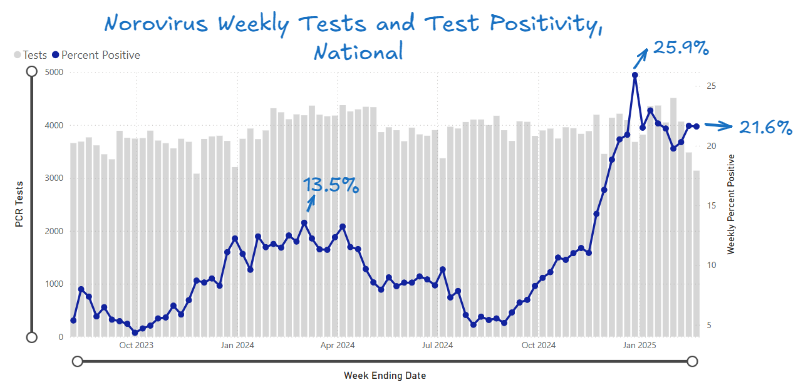Respiratory Diseases
Influenza-like illness
I am happy to report that outpatient influenza-like illness (ILI) dropped for the second week in a row. During the week ending February 22nd, 5.8% of visits to the doctor were for fever and cough or sore throat. This is a significant decline from last week's 6.8%. However, we are still far from the national baseline of 3% that will mark the end of flu season. Still, I am heartened both by the arrival of March (hoping for spring weather soon!) and the week-over-week improvements in outpatient ILI.
Parents, including yours truly, will also be relieved by the improvements in flu-like activity in children. In the 0-4 age group, 15.0% of visits to the doctor were for fever and cough or sore throat, down from a recent peak of 18.1%. In school-age children, too, there have been big declines from 12.6% to 9.6%—still high but promising. Older age groups range from 3.2% to 5.5%, and declines are seen across the board.
Metrics of severe illness are also improving. The percent of emergency department visits that are for influenza have dropped sharply across all age groups, particularly among children. Inpatient stays for influenza (shown below) are receding as well.
The Southern region, which was especially hard hit during these last few weeks, has seen substantial improvements with many states falling from the very high category to the high category. The Mountain West is in okay shape too, but much of the rest of the country is still experiencing high or very high levels of activity. Standouts with high activity include Michigan, Ohio, Massachusetts, New Hampshire, and Maine. Still, with improvements seen in all age groups and all areas of the country, I expect those states to log improvements in the weeks ahead.
COVID-19
Overall, Covid-19 activity is fairly okay, with little at either extreme. Covid-19 wastewater activity is moderate at the national level, and decreased in all four regions. Only one state reported very low wastewater activity this past week (New York) and none reported very high activity. Wastewater activity is highest in the Midwest and South, both of which are ~1.7-2x the activity in the Northeast and West.
Severe illness is low. Emergency department visits for Covid-19 remain at minimal levels, accounting for 0.8% of all ED visits nationally last week. The vast majority of states reported stable or decreasing ED visits. Hospitalizations have been decreasing little by little over the past two months, and are now down to a low 3.0 hospitalizations per 100,000 people, down from a more moderately elevated rate of 5.4 at the beginning of the year.
RSV & Other Bugs
The bottom line is RSV activity is fairly low across the country and falling.
One peculiarity: the percent of tests that are positive for RSV, which is an imperfect metric but one I take into account nonetheless, rose slightly during the last report from 6.4% to 7.0%.
However, hospitalizations and emergency department visits for RSV are declining steadily, and so I don’t have concerns about the blip in test positivity at this point.
A couple of the other common causes of cold and flu-like symptoms are quite high right now. Human coronaviruses are at their highest levels yet this season, and human metapneumovirus is also quite high.
Norovirus
Ick. Norovirus rates remain miserably high, with 21.6% test positivity this past week. There has been basically no change in the past week, and rates have been hovering at extremely high levels since December. Rates are worst in the Midwest, followed by the Northeast and South.

Food recalls
The following foods are being recalled because they are contaminated. Please check your cupboards and throw out any of these items:
New:
Lyons ReadyCare and Sysco Imperial Frozen Supplemental Shakes in various flavors (more info)
Previously reported:
Menma Ajitsuke Prepared Bamboo Shoots sold under Choshiya brand name (more info)
Canned Tuna sold under Genova, Van Camp’s, H-E-B, and Trader Joe’s brand names (more info)
If you have food allergies, you may wish to review these FDA safety alerts and USDA alerts for foods with undeclared allergens.
In other news
The large outbreak of measles in West Texas continues to grow, with 146 cases and 20 hospitalizations reported. Sadly, the first U.S. measles death since 2015 was reported last week. An unvaccinated, school-age child passed away from infection. Another nine cases are reported on the New Mexico side.
The UK Health Security Agency (UKHSA) is warning of a potential second wave of norovirus, with cases at record highs since reporting began in 2014. This is of interest because the United States often follows UK trends. Laboratory-confirmed cases in early February 2025 were nearly 30% higher than the previous fortnight and more than double the five-season average. While the recently emerged GII.17 genotype remains dominant (59% of cases), the common GII.4 strain is rapidly increasing (now 29%, up from 10% three months ago). This means people who have already had norovirus this season could become reinfected with a different strain.
The Food and Drug Administration alarmed experts by canceling a planned meeting of the Vaccines and Related Biological Products Advisory Committee, which comprises independent, non-governmental experts who advise the government on vaccine-related matters. The upcoming meeting was meant to advise on which strains should be included in next year's flu vaccine, and the cancellation prompted concerns about vaccine availability. However, the FDA stated: "FDA, in consultation with our federal partners, will review the available data to make our recommendations to manufacturers of U.S.-licensed influenza vaccines in time for the production of updated vaccines for the 2025-2026 influenza season. We do not anticipate any impact on vaccine supply or timing of availability."
A CDC report found that the 2024-2025 Covid-19 vaccine was 33% effective against Covid-19-associated emergency department or urgent care visits among adults 18 and older, and 45-46% effective against hospitalizations among immunocompetent adults 65 and older. For immunocompromised adults 65 and older, vaccine effectiveness against hospitalization was 40%. These findings represent the added benefit of the 2024-2025 vaccination beyond existing protection from previous vaccination or infection.
A CDC report on interim 2024-2025 seasonal influenza vaccine effectiveness (VE) shows significant protection across all age groups. Data from four U.S. surveillance networks indicates the vaccine reduced both outpatient visits and hospitalizations due to influenza. Among children and adolescents, vaccine effectiveness ranged from 32% to 60% in outpatient settings and from 63% to 78% against hospitalization. For adults, effectiveness was 36% to 54% in outpatient settings and 41% to 55% against hospitalization.
Get detailed, state-specific public health updates with regional editions—available to paid subscribers. Stay informed where it matters most to you!




Awesome! Thank you for pulling this update together!
Thank you! This is great.